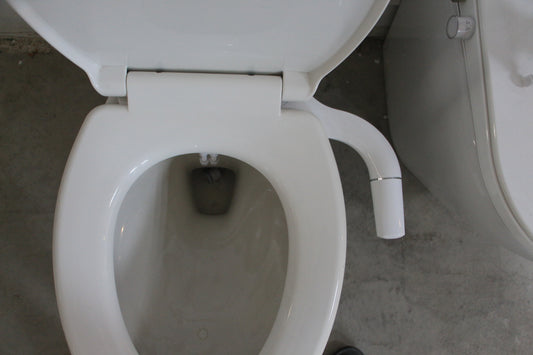In today's world, maintaining hygiene is more crucial than ever. With the increasing popularity of bidets, understanding bidet safety tips becomes essential for ensuring both clean and safe usage. Whether you're using an electric or non-electric bidet, these tips can help you maximize your bidet experience while keeping safety at the forefront.

Understanding Bidet Basics
Before diving into specific bidet safety tips, it's important to understand the basics of bidets. A bidet is a bathroom fixture designed to clean the genital and anal areas after using the toilet. There are various types of bidets available, ranging from traditional standalone fixtures to modern bidet attachments and seats. Each type has its own set of features and safety considerations, which makes understanding the differences crucial for safe usage. For a deeper dive into the different types of bidets, you can explore this comprehensive guide.
Electric vs. Non-Electric Bidets: Safety Considerations
One of the primary distinctions between bidet models is whether they are electric or non-electric. Electric bidets offer additional features such as heated seats, warm water, and air drying. However, these features come with added safety considerations. For instance, ensuring the electrical components are properly insulated and the unit is installed by a professional can prevent potential hazards. On the other hand, non-electric bidets are simpler but require manual operation. Understanding the differences between these models and their respective safety tips is crucial. You can learn more about the specific distinctions in this comparison of electric and non-electric bidets.
Proper Installation: A Key to Safety
Regardless of the bidet type, proper installation is fundamental for safety. Incorrect installation can lead to leaks, electrical hazards, or even damage to your bathroom. It's recommended to hire a professional plumber or electrician, especially when dealing with electric models. They will ensure that all components are securely fitted and that the electrical connections adhere to safety standards. For those considering DIY installation, following the manufacturer's guidelines and using the right tools is essential for preventing mishaps.
Temperature Control: Avoid Burns
One of the appealing features of many bidets is their ability to provide warm water. However, high temperatures can pose a burn risk, especially for children and the elderly. Always test the water temperature before use and opt for models with adjustable temperature settings. This feature allows you to set a safe, comfortable temperature, minimizing the risk of burns. Additionally, some bidets come with automatic temperature control, which can be a beneficial safety feature.
Regular Maintenance: Ensuring Long-Term Safety
Regular maintenance is key to ensuring the long-term safety and functionality of your bidet. This includes cleaning the nozzles, checking for leaks, and ensuring that all components are in good working condition. Regular maintenance not only extends the lifespan of your bidet but also prevents potential safety hazards. For more tips on maintaining your bidet, the New York Times offers a practical guide on how to clean and maintain your bidet effectively.
Hygiene Practices: More Than Just Water
While bidets are designed to enhance hygiene, it's important to integrate them into a broader hygiene routine. This includes washing hands thoroughly after using the bidet and ensuring the bidet itself is kept clean. Consider using mild, non-abrasive cleaners to avoid damaging the bidet's surfaces and mechanisms. Additionally, if your bidet features a detachable nozzle, consider removing and cleaning it regularly to maintain optimal hygiene.
Addressing Common Bidet Misconceptions
Despite their growing popularity, there are still many misconceptions surrounding bidets. Some people worry about hygiene, while others are concerned about their complexity. Understanding and addressing these misconceptions can help you use your bidet safely and confidently. For a detailed exploration of common bidet misconceptions, this resource provides valuable insights.
Bidet Usage for Different Demographics
Bidets can be beneficial for people of all ages, but specific safety tips should be considered for children and the elderly. For instance, children should be supervised to ensure they use the bidet safely and don't adjust the settings to unsafe levels. Similarly, elderly individuals may need assistance with adjusting settings or ensuring they are seated properly to prevent slips or falls. Understanding these demographic-specific tips can enhance safety for all users.
Conclusion
Bidets offer a modern solution to personal hygiene, but understanding and implementing bidet safety tips is essential for a safe and enjoyable experience. From proper installation and regular maintenance to understanding specific safety features, these tips will help you maximize the benefits of your bidet while minimizing risks. By staying informed and proactive, you can ensure that your bidet remains a safe and hygienic addition to your bathroom.

FAQs
What are the key safety features to look for in a bidet?
When choosing a bidet, look for safety features such as adjustable water temperature, automatic shut-off, and user-friendly controls. These features can help prevent burns and ensure a safe experience for all users.
How often should I clean my bidet?
It's recommended to clean your bidet at least once a week. Regular cleaning helps maintain hygiene and ensures that all components are functioning properly.
Can bidets be used by children?
Yes, bidets can be used by children, but they should be supervised to ensure they use it safely. It's important to set appropriate temperature levels and guide them on proper usage.
This article contains affiliate links. We may earn a commission at no extra cost to you.






